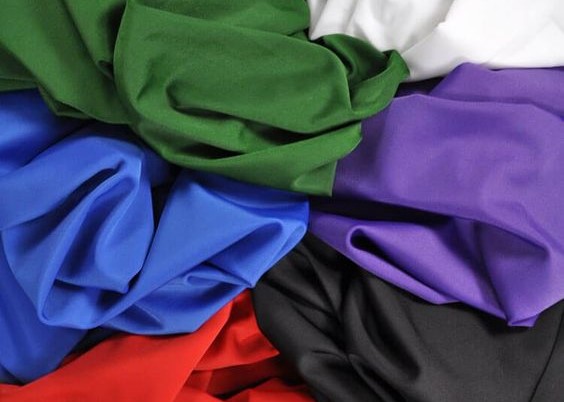Welding clothes material is an important factor to consider for your safety and well being. The American Welding Society made several welding recommendations. The fabric should be thick cotton or wool with no holes, rips, or frayed edges.
Synthetic materials like rayon, polyester and spandex are dangerous because they melt and inflict serious burns to your skin.
Spandex is not a good choice for welding since it sticks to your body, does not enable your skin to breathe freely, and is heat sensitive.
What is Spandex and why is it not Suitable while Welding?
Spandex is a synthetic fabric known for its flexibility. The names spandex, Lycra, and elastane are all interchangeable. This fabric has the ability to stretch to 5-8 times its original size and is often used in form-fitting consumer garments.
Rather than using pure spandex in clothes, modest amounts of this fabric are woven with other synthetic, semi-synthetic, or organic fibers.
Because spandex is a completely manufactured textile, it has no biological components. Instead, all of the essential pieces of this fiber are created in a laboratory and then united under particular conditions to produce spandex fabric.
Here are Reasons why you cannot Employ Spandex while Welding
1.) Captures Moisture
Because spandex is unable to breathe moisture, it is unsuitable for sweat-inducing activities such as exercising or trekking. And since welding requires workers to deal with extremely high heat, it is not suitable for welding work.
Trapping perspiration near your skin not only causes an unpleasant odor, but it also raises your risk of yeast infections and scorching around clothing seams.
2.) It can induce Fungal or Bacterial Skin Infections.
Another significant adverse effect of spandex’s inability to absorb perspiration is that your skin can become a breeding ground for fungal or bacterial infections.
Ringworm, which causes skin inflammation in the shape of red rings with a center pigmentation, is one of the most prevalent skin disorders produced by this synthetic substance.
Wearing spandex on a daily basis can only make you more susceptible to skin allergies. Moisture becomes retained because spandex does not absorb sweat, allowing allergens to penetrate the skin.
This is due to the fact that spandex is a polymer fabric comparable to plastic, and the production process necessitates the usage of raw materials as well as harmful chemicals.
3.) It is Slippery and Not Very Safe
The use of spandex in clothing makes the fabric exceedingly slick and smooth, reducing friction between the clothing and the surface. This may endanger the wearer, especially when working in an hazardous environment.
To overcome the limits of these spandex fibers, spandex is frequently mixed and blended with other natural and breathable fibers like cotton.
4.) Heat Sensitive
Because of the chemical nature of spandex fabric, it is heat sensitive which makes it a bad choice while welding. It has a poor heat resistance, which causes it to twist when it comes into contact with a flame.
Washing spandex in hot water, machine drying, or ironing produces puckering and permanently damages the fabric.
Multiple outfits made entirely of spandex merge and fuse together in the dryer at high temperatures. Because of its heat sensitivity, spandex requires more time for basic care and maintenance than less heat sensitive textiles.
5.) Less Durable
Aside from the negative health consequences of wearing spandex, another significant disadvantage is that these clothing or undergarments have a relatively limited shelf life. And welders require clothes that are strong and durable which also allows them to breathe.
This is because it tends to become loose and shapeless after a few washing. Furthermore, because it cannot be washed in hot water, the basic care and maintenance of this material is far more time consuming than that of cotton items.
6.) Negative Impact on the Environment
Overall, spandex has adverse environmental impacts. Spandex and other non-biodegradable textiles will remain on the globe long after human civilisation has vanished, and there are currently no known ways for converting spandex fibers and related polymers into biodegradable compounds.
The only method to reduce the environmental effect of this fabric is by proper disposal and minimal wastage.
Okay, so apart from spandex, there are other fabrics too that are not at all suitable for welding.
Different Fabrics that Shouldn’t be used While Welding
1.) Nylon
Wearing nylon clothing when welding is not recommended since it is a synthetic fabric that shrinks when burnt.
It is easily ignited by a single spark, sticks to the skin, and aggravates burns. Even after the fire has been extinguished, nylon fibers stay adhered to the skin, inflicting more injury.
2.) Polyester
Wearing polyester clothes when welding is not a good idea because:
-
-
- They melt quickly
- They generate a hot, sticky ash that can burn your skin severely
- They catch fire and flame with a single spark.
- It adheres to the skin and aggravates the burns.
-
3.) Acrylic
Rayon, or Viscose as it is known in Europe (which is simply another term for basic Rayon), is a semi-synthetic, cellulose material.
The initial ingredient is wood from many types of trees. When the cloth becomes wet, it loses strength and it is not stretchy on its own.
4.) Rayon
Acrylic may be spun wet or dry. Solvents are used to dissolve the polymer, which is then solidified for the spinning process. It has color retention, wool-like texture, and wrinkling resistance.
However, it gives relatively poor insulation, and it melts as it burns, which is why acrylic textiles cannot be used for welding work.
5.) Acetate
Acetate is manufactured from biodegradable and naturally occurring materials, particularly wood shaving. It is a man-made cloth that has a similar look to silk. It is one of the most adaptable textiles and is resistant to wrinkling. It has a smooth appearance and a pleasant feel.
Whereas the downsides are it is heat sensitive, and it is a rather weak fiber.
So What type of Materials are Suitable for Welding Work?
We have previously covered this topic in our other article, however, let me give you a brief introduction on the suitable types of welding fabrics.
1.) Cotton: Using cotton while welding is an inexpensive way to protect yourself from flames, sparks, and molten splash. FR (Flame Retardant) cotton is a fabric that has been chemically treated to be heat resistant.
Cotton fabric dresses are a lightweight, breathable alternative to leather, and it sure does take care of your comfort too.
2.) Leather: Welding leather clothing is made of extremely robust and heavy side split cow leather. Chrome tanned leather is supple and durable, with resistance to heat, sparks, slag, and cuts. All seams are double lock stitched and sewn with Kevlar thread.
3.) Denim: While not ideal for welding activities, denim is a thick, robust material that will protect welders in low-volume, low-intensity operations.
4.) Rubber: Although not commonly used for welding jackets or caps, rubber is used in welding chaps, boots, and boot coverings because of its various, excellent properties.
Conclusion
Spandex is a synthetic fabric that is not suitable for welding clothes because it has a low heat resistance. It does let your skin breathe and may cause various skin infections as well.
However, it is useful as it can be blended for making training and exercising clothes because of its flexibility.








